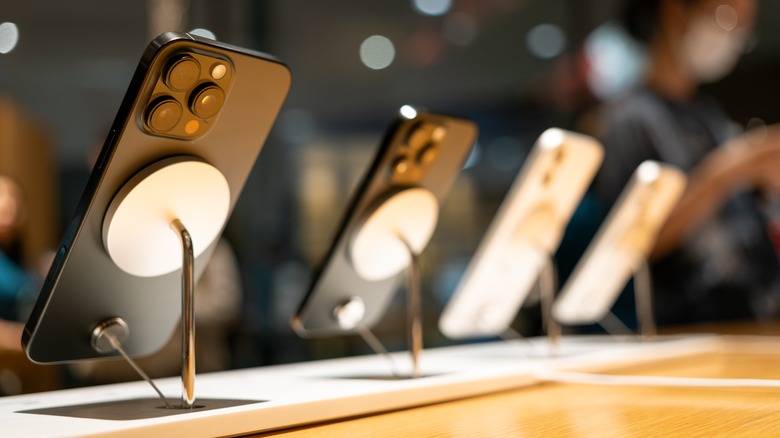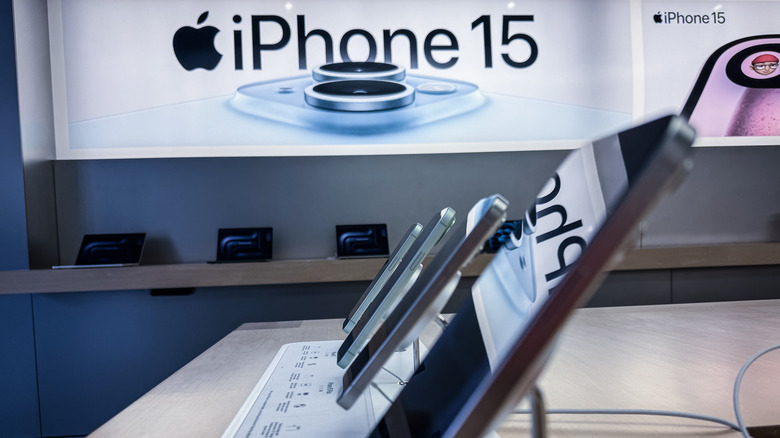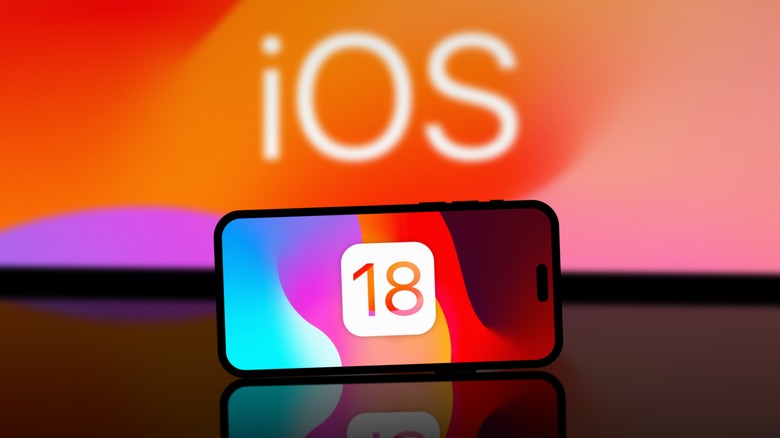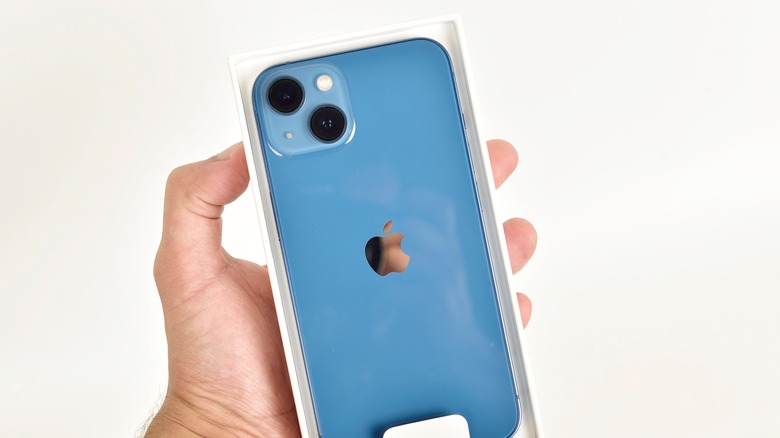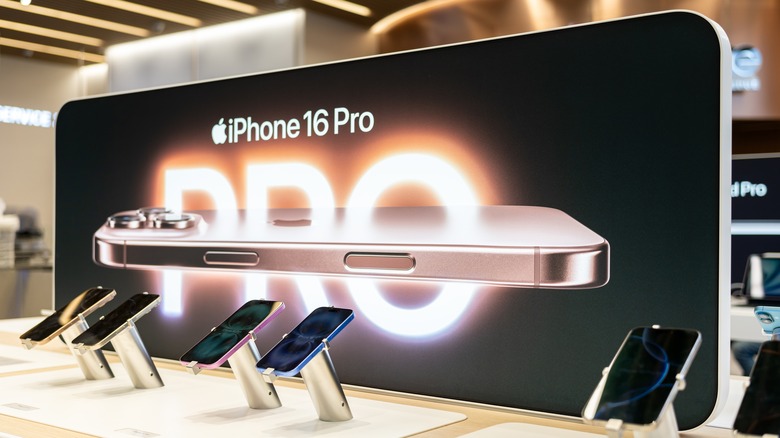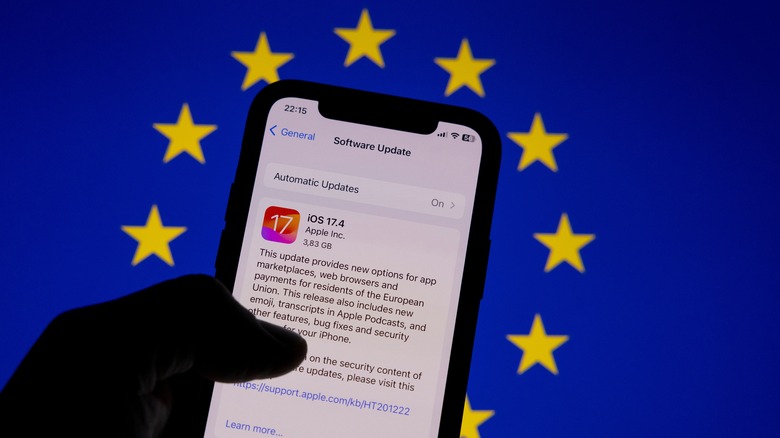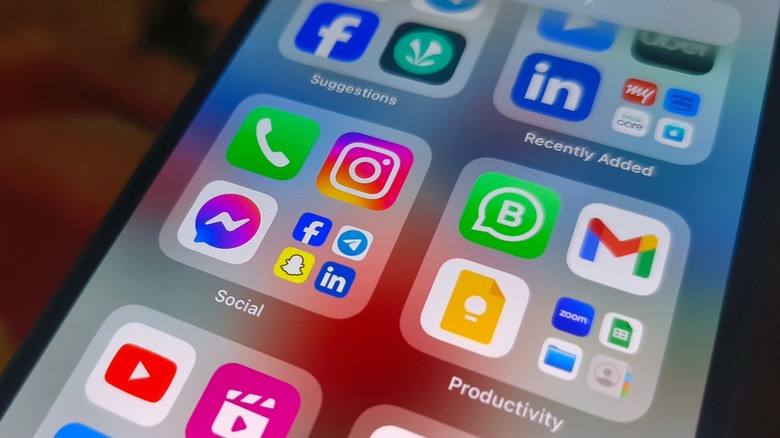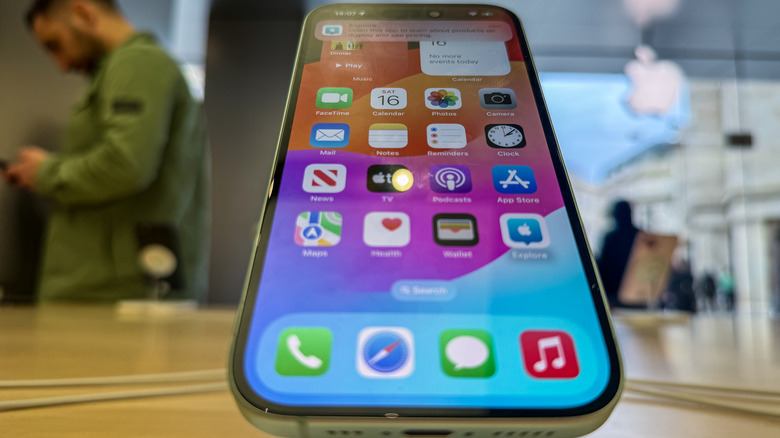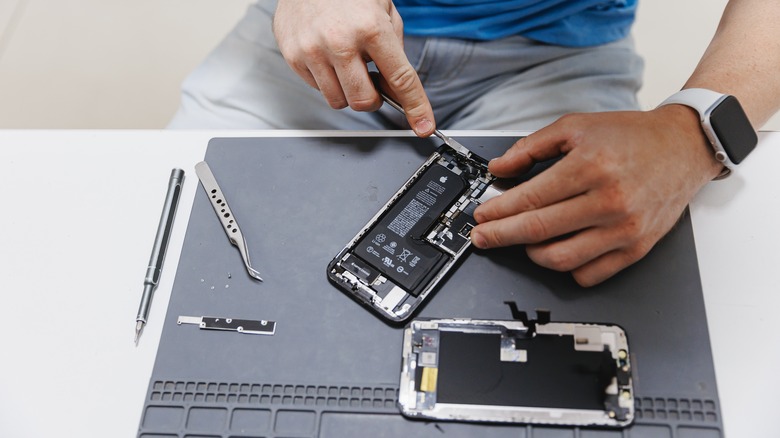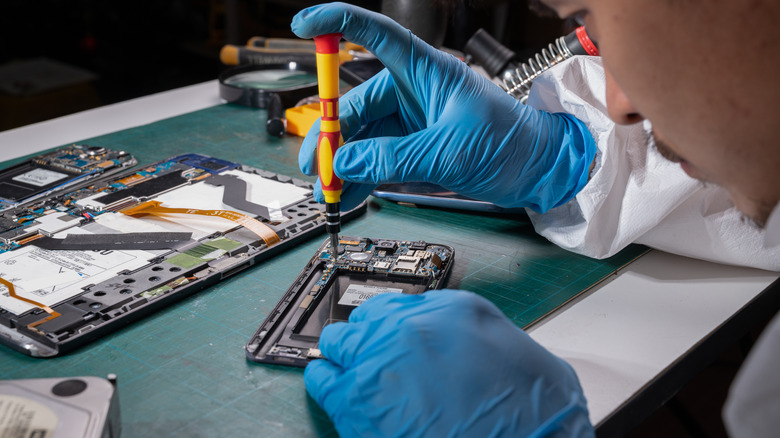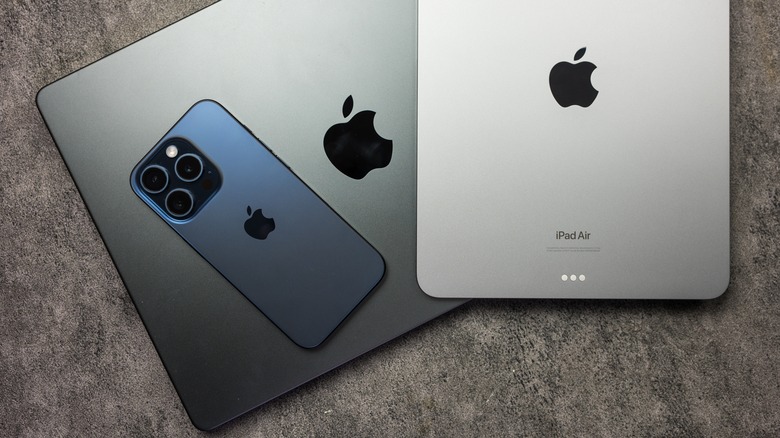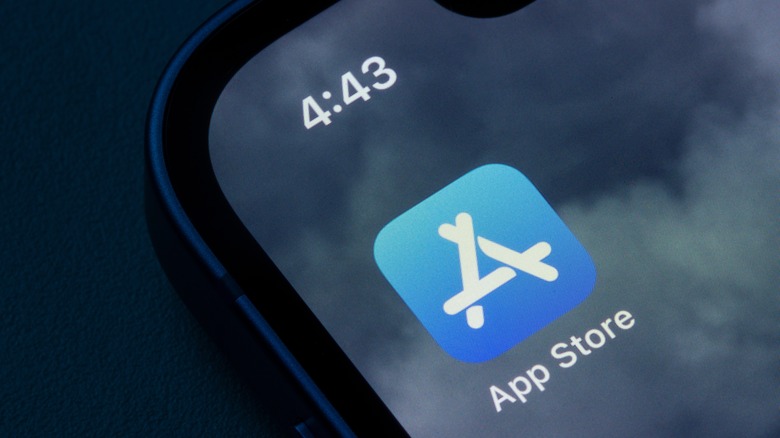12 Things You Should Know Before Buying An iPhone (New Or Used)
Talk to any diehard Android user and you'd be led to believe iPhones are objectively inferior. Their arguments note iPhones are overpriced luxury devices with last year's hardware, last decade's software, embarrassingly limited customization, and poor repairability. Some of that is true, yet somehow people keep buying iPhones — and in increasing numbers. In 2023, Apple won the title of having the largest market share. 52% of U.S. customers own one, a market share that has remained steady since 2023 despite overall U.S. smart shipments declining during the same period (via Counterpoint Research). Apple isn't perfect, but it is doing something right. Might be pressure from blue-bubbled friends, might be the simplicity of iOS, might be the ecosystem. Whatever the reason, if you're an Android user planning on buying an iPhone, don't make that purchase until you understand these hardware and software considerations, along with tips on buying an iPhone used.
Only iPhone 15 (and above) have USB-C
For years, Apple clung to the controversial Lightning connector, forcing users to keep separate cables for their Apple products and for everything else. Not anymore. Beginning with the iPhone 15, USB-C is the norm for both the standard and Pro models. Ergo, if you want USB-C, you will need to buy a 15 or above.
One important item of note: the USB-C standards on iPhone models are not identical. The iPhone 16 and 16 Plus both support USB 2, which can handle up to 480 Mb/s. However, the iPhone 16 Pro and Pro Max support USB 3, a massive jump to 10 Gbps. Though to be fair, this is really only going to affect you if you plan to plug your iPhone into your computer to transfer large files. For the small stuff — some pictures or documents — the difference will be negligible, especially if your computer doesn't support USB 3.
Also, do be careful if you decide to buy accessories for your iPhone, like AirPods. Apple upgraded the AirPods Pro 2 to USB-C, but if you buy them from a third-party retailer you might accidentally pick up the Lightning version — likely if there is a deep sale. Pay extra close attention to the spec sheet unless you don't mind using Lightning.
iPhones only get five to six years of support
It's not just you, people really are keeping their phones for longer and longer. On average, U.S. consumers replace their smartphone about once every 2 1/2 years (via Statista). Phone manufacturers do still try to get you to buy the latest and greatest each year, but they've massively extended how long they support older devices. The official answer to how long iPhones will receive software updates is five years — great, but not as great as Samsung and Google, which both now support seven years of software updates on their newer devices.
To be fair, this is five years of software and security updates; aside from Apple Intelligence, you will be getting all the latest iOS features on a supported device. The same can't be said for many Android manufacturers who push a couple years of feature updates, followed by a few more for security only.
Further, Apple's five-year commitment isn't a hard rule. The tech giant frequently goes as far as six, and a phone may last up to eight. Apple may also occasionally release a critical security update for an unsupported device, though this is no guarantee and really depends on how severe Apple deems the issue to be.
Buy Apple refurbished for a new battery and AppleCare
iPhones are great used devices because of how well they hold up, but buying used comes with downsides that are more pronounced for an Apple device. One, since battery capacity won't be as great, replacing a battery on an iPhone battery is notoriously expensive — $89 for an iPhone 13, for example. Two, Apple has a fairly short one-year limited warranty, and there's no way to get AppleCare insurance for used devices. If you'd like a used device with a brand-new battery and the option to buy AppleCare — and the discount for buying used — then go the route of Apple's Certified Refurbished service.
For starters, you are guaranteed a clean, fully functioning device that has had any prior issues fixed, plus a new shell; you get a new one-year limited warranty, similar to a new Apple device, and the option to purchase AppleCare. The battery is brand-new and, finally, you get free shipping, free returns, and the option to get 3% Daily Cash on your Apple Card.
All in all, not a bad deal for a like-new device that could be up to 15% off. It's a lot more comforting to buy it directly from Apple, since it's hard to trust a third-party or a random individual off a local marketplace.
Only 15 Pro and above get Apple Intelligence (and AAA games)
Is one of the reasons you're buying an iPhone the promise of Apple Intelligence? Or the possibility of playing "Assassin's Creed Shadows" (and other AAA titles) on a smartphone? Make sure you are buying a model that supports both. This isn't like gaming on the iPad or Mac, where any M-series device can play the modern, AAA titles that have arrived on Apple Silicon. You can grab an M1 iPad from as far back as 2021 or an M1 Mac Mini from 2020 — and they support Apple Intelligence as well. Apple Intelligence and AAA gaming only work on the 2023 iPhone 15 Pro (and above).
That said, you may not be missing out on much if you go for an older device. Apple Intelligence is not fully released; currently, 18.1 only supports a small portion of the features originally teased in WWDC 2024. The next iOS update in December (18.2) adds even more, but not much more. Apple Intelligence is still technically in beta, and won't be "complete" until 18.4 in the spring of 2025.
As for AAA games, there aren't very many to play. There are about a dozen titles ranging from "Resident Evil," to "Assassin's Creed," to "Death Stranding," many of which have eye-watering prices — painful if you've already purchased one of these titles on another platform. Plus, performance and thermals on the iPhone 15 Pro weren't great; the 16 Pro did much better. Unless you are big on these two fronts (and you plan on buying a used iPhone) then save a bit of money with an iPhone 15 or below.
Sideloading isn't possible (outside the EU)
As evidence of how much more customizable and free Android tends to be compared to iPhone, you can sideload any app you want on an Android device. Sideloading means downloading apps outside Google Play Store, such as from open-source repositories like F-Droid, or indie game stores like Itch.io. While you do have to accept the risk that comes with putting something on your device that hasn't been vetted by Google, it's a breath of fresh air being able to download any app you want — such as downloading an app that's only available outside your region. Sideloading is now possible on the iPhone, but only in one specific place: the European Union.
According to Apple, there's no easy way to hop on the sideloading gravy train unless you're an actual EU resident. You can't just change your region to an EU country and connect via VPN to that country; your Apple account must be set to that region and you must be physically present. Tricking your iPhone into changing your physical GPS location will be difficult, especially given how your iPhone intelligently decides where you live depending on how long you stay in "significant locations." Long story short, everyone outside the EU needs to get comfy with the fact that sideloading probably isn't coming to additional regions anytime soon — so if that matters to you, stick with Android.
You cannot change most default apps (outside the EU)
On Android, you can change the default app for just about everything: the phone app, messaging app, your digital assistant, and so on. On iPhone, you can really only change the default browser or email client. You are more or less forced to use the Apple defaults like Messages, Camera, or Photos. You can still use third-party alternatives as much as you like, you just won't be able to set them to open automatically for their relevant category. In the EU, however, that limitation will soon be gone.
In coming iOS updates, EU residents will be able to change the default in almost every category: default App Store, messaging and calling app, camera app, photos app, translation app, keyboards, passwords app, and more. In 18.2, there will be a new Default App section in Settings — which, if you live in the EU, will be much more comprehensive than the rest of the world.
It's impossible to say if and when other governments around the world will copy the EU and let us enjoy that freedom as well. So if you're OK with Apple's defaults like calling and texting — which, to be fair, have been improving a lot of late — this won't be too big of a downside. Regardless, we do hope the Apple App Store changes in 2024 for alternative browser engines do eventually trickle down to the rest of the world, regardless of regulatory changes.
Only the iPhone Pro and Pro Max have 120Hz screens
If you haven't yet experienced a 120Hz smart TV screen or gaming monitor — or in this case, smartphone — then you've been missing out. The difference between 60Hz (the default for modern screens) and 120 Hz is night and day. Try using a phone with a 120Hz refresh rate for a couple of hours, then switch back to one with a 60Hz refresh rate. The 60Hz phone will immediately feel sluggish and choppy. Most midrange and flagship Android phones ship with 90Hz or 120Hz screens — and so do quite a few budget phones, like the $200 CMF Nothing 1. So, you might come to the conclusion that an $800 iPhone 16 would have a 120Hz screen, right? Nope.
Despite costing flagship prices, Apple's baseline iPhone continues to have a 60Hz screen, same as the original 2007 iPhone. To get 120Hz, you need to buy the iPhone 16 Pro — or any Pro version going back to the 13 Pro. One of the reasons you should wait for the iPhone 17 is because it will likely have a 120Hz screen on the base model. It's a similar situation with MacBooks, where only the MacBook Pro has a 120Hz display.
Many users don't really care about or notice the upgrade to 120Hz; this tends to be a concern primarily for nerds and power users. Regardless, it is something to consider. As a general rule when buying Apple products, never assume that the "Apple Tax" is getting you the best.
Repairing can be tricky (and expensive)
Android phones can occasionally have reprehensible "don't open this phone or you'll void your warranty" policies, but they pale in comparison to Apple. One bugbear of every Apple user is how expensive and problematic something as simple as replacing a battery can be. First, Apple restricts who can perform repairs in the first place. Only independent repair shops that have received its blessing are allowed to fix your iPhone with genuine parts. Otherwise, you have to go straight to Apple and pay exorbitant prices if you didn't purchase its AppleCare+ repair insurance.
Fixing a cracked screen on an iPhone 16 will cost you $279 out of pocket, or $29 if you have an AppleCare+ plan. Insuring the latest iPhone 16 for damage and/or theft and loss costs an eye watering $11.49 per month, or $219 for two years. That premium may be essential if you have butter fingers or you're worried about your phone being swiped by thieves in a public place.
Granted, you can do your own self-service repair for less, but this comes with its own troubles. Even if you use genuine parts and disable activation lock, it's common for an iPhone to disable features anyway. Long story short, you can't just crack open an iPhone and swap out the battery if you're handy with electronics, like you would on an Android device — and your pocketbook will hurt if you ever need to.
Be extra careful that a used iPhone wasn't stolen
If you're still bent on buying an iPhone (particularly a used one) then do take a few extra steps to make sure the device isn't stolen. Apple has gone to great lengths to prevent stolen devices from being wiped and used by thieves — great for anyone whose device has been stolen, but not so great if a thief pawns it off on an unsuspecting buyer. You'll think you're getting an iPhone for a steal (pun intended), only to find out later that you can't reset it or use it in any meaningful way. Worse, the original owner may be able to see the phone's location through Find My (AKA your location) even if you didn't do anything wrong. Said users can mark a device as lost, which could lock you out of the phone entirely.
So if you do buy an iPhone used, we highly recommend buying it in person. Don't hand over any money until you've checked for certain that it's not a stolen device. Once you've ensured it's unlocked, input the IMEI (found in General > About) into a website like imeipro.info or Apple's Check Coverage tool. Usually, this should make it clear if the device has been blacklisted, which means it was stolen and reset by a workaround.
Check for non-genuine parts
Before you pay for that used iPhone, we also recommend checking whether it has full functionality. The device may not be stolen, but the person selling it may have fixed it with non-genuine parts. The iPhone would appear to be in full working order, but you would later discover that certain basic functionality no longer works. Apple has an entire page dedicated to each and every hardware item you should check for before buying a used iPhone.
Go into Settings then General > About and look for a section labeled Parts and Service History. This section will only be there if any parts have been replaced — an immediate warning to you that the iPhone has been repaired at some point. Double and triple check that all repairs have been made with genuine parts. Anything other than these will have the label Unknown Part. That's effectively a dealbreaker since there's no telling if the part was installed incorrectly, or if it's an unsupported third-party part. We recommend rejecting any iPhone that has any non-genuine parts to avoid potential headaches later on.
It's because of iPhone blacklisting and non-genuine parts that you should only buy an iPhone from Apple or a respectable third-party retailer. Thieves have targeted iPhones for years because of how easy it is to reset them, and if not reset them, steal them and sell them for parts. Apple has been taking small, baby steps, often far too late, to thwart this iPhone black market. Regardless, we mention all of this so you are exceptionally cautious around used iPhones.
iPhones pair best with other Apple products
If you already own a MacBook, iPad, and/or AirPods, then you're in luck. A number of features will work seamlessly with your new iPhone, right out of the box. Universal Clipboard will instantly share any copied items, you'll be able to use your iPhone camera as a web cam with continuity camera on Mac, and you'll be able to use Handoff to transfer whatever you're doing straight to your Mac — or control your iPhone directly on your Mac with iPhone Mirroring. If you have a Windows computer or another brand of Bluetooth earbuds, then you can forget about all of that.
For example, you won't have automatic AirPods switching. If you use your Bluetooth headphones on another device, and want to re-connect them to your iPhone, you'll have to do it manually just as you would on any other platform. If you want that same smooth integration on iPhone and Mac with your iPhone and Windows computer, you'll have to install Phone Link — and even then it won't be as comprehensive. It'll be expensive to flesh out a complete Apple ecosystem, but that may be worth it.
Apps tend to cost money
Yes, it's true, iPhone users spend seven times as much on apps as their Android counterparts. On Android, you're probably used to the vast majority of your favorite apps being 100% free to use, plus a few ads. iPhone is a bit different. Apps that are free on Android can sometimes cost money on iPhone. A great example is the popular flashcard app, Anki. On Android it's totally free to use, but it costs a whopping $24.99 on the App Store for the exact same experience.
Further, there are other ways that iPhone can be more expensive in this regard. For example, subscriptions bought through the App Store are more expensive than if you were to buy them directly from the developer's website. Subs to everything from Audible to Tinder Plus cost a few dollars extra on the App Store because Apple takes its cut. Always check the website, since you can likely get a cheaper subscription.
